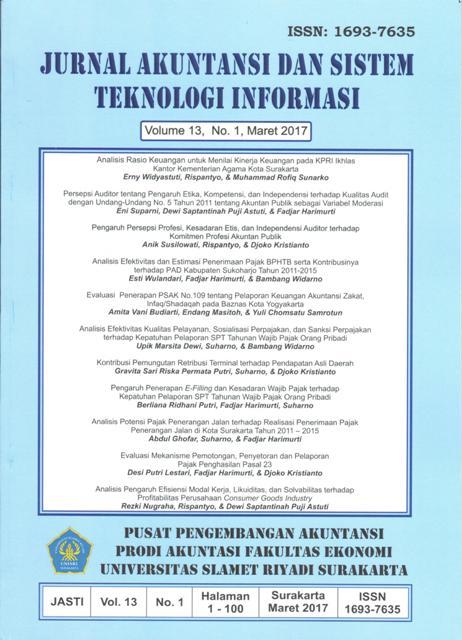ANALISIS EFEKTIVITAS DAN ESTIMASI PENERIMAAN PAJAK BPHTB SERTA KONTRIBUSINYA TERHADAP PAD KABUPATEN SUKOHARJO TAHUN 2011-2015
Abstract
The purpose of research is to analyze the effectiveness and estimation a tax
revenue of Tax on Acquistion of Land and Building as well as its contribution to the
local revenue in Sukoharjo regency on 2011 – 2015 year. This research is the case
study in Sukoharjo regency goverment on 2011 – 2015 year. This research took a
secondary data from DPPKAD Sukoharjo regency. Technical analysis of the data
used the analysis of effectiveness, analysis contribution and analysis estimation. The
results of the analysis effectiveness concluded that the tax BPHTB in 2011 – 2015
year had an average effective rate of 138,26%, this shows that a tax revenue BPHTB
on 2011 – 2015 year,can said to be effective as a percentage of more than one
hundred percent effectiveness. The analysis of contribution a tax BPHTB to the local
revenue in Sukoharjo regency on 2011 – 2015 year had an average contribution rate
of 16,15%, this shows that the contribution to the local revenue in Sukoharjo regency
on 2011 – 2015 year is said to to greatly contribute for more than four percentage
contribution percent. While the analysis of tax revenue estimation of BPHTB 2016 –
2018 year is more increase every
Keywords: Tax BPHTB, effectiveness, estimates, contributions, local revenue.
Downloads
Published
Issue
Section
License
Authors who publish this journal agree to the following terms:
- Authors retain copyright and grant the journal right of first publication with the work simultaneously licensed under a Creative Commons Attribution License that allows others to share the work with an acknowledgement of the work's authorship and initial publication in this journal.
- Authors can separately make additional contractual arrangements for non-exclusive distribution published by the journal (e.g., publish it in a book), with an acknowledgement of its initial publication in this journal.
- Authors are allowed and encouraged to send their work via online (e.g., in the institutional repositories or their website) after published by the journal.










